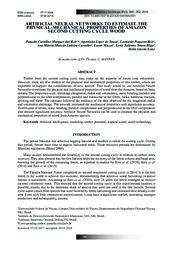Artificial neural networks to estimate the physical-mechanical properties of amazon second cutting cycle wood.
Artificial neural networks to estimate the physical-mechanical properties of amazon second cutting cycle wood.
Author(s): REIS, P. C. M. dos R.; SOUZA, A. L. de; REIS, L. P.; CARVALHO, A. M. M. L.; FREITAS, L. J. M. de; RÊGO, L. J. S.; LEITE, H. G.
Summary: Timber from the second cutting cycle may make up the majority of future crop volumetric. However, there are few studies of the physical and mechanical properties of this timber, which are important to support the consolidation of new species. This study aimed to use Artificial Neural Networks to estimate the physical and mechanical properties of wood from the Amazon, based on basic density. The properties were: shrinkage (tangential, radial and volumetric), static bending, parallel and perpendicular to the fiber compression, parallel and transverse to the fibers, Janka hardness, traction, splitting and shear. The estimate followed the tendency of the data observed for the tangential, radial and volumetric shrinkage. The network estimated the mechanical properties with significant accuracy. Distribution of errors, static bending, parallel compression and perpendicular to the fiber compression also showed significant accuracy. Artificial Neural Networks can be used to estimate the physical and mechanical properties of wood from Amazon species.
Publication year: 2018
Types of publication: Journal article
Unit: Embrapa Eastern Amazon
Keywords: Inteligência artificial, Madeira, Modelagem, Tecnologia
Observation
Some of Embrapa's publications are published as ePub files. To read them, use or download one of the following free software options to your computer or mobile device. Android: Google Play Books; IOS: iBooks; Windows and Linux: Calibre.
Access other publications
Access the Agricultural Research Database (BDPA) to consult Embrapa's full library collection and records.
Visit Embrapa Bookstore to purchase books and other publications sold by Embrapa.

